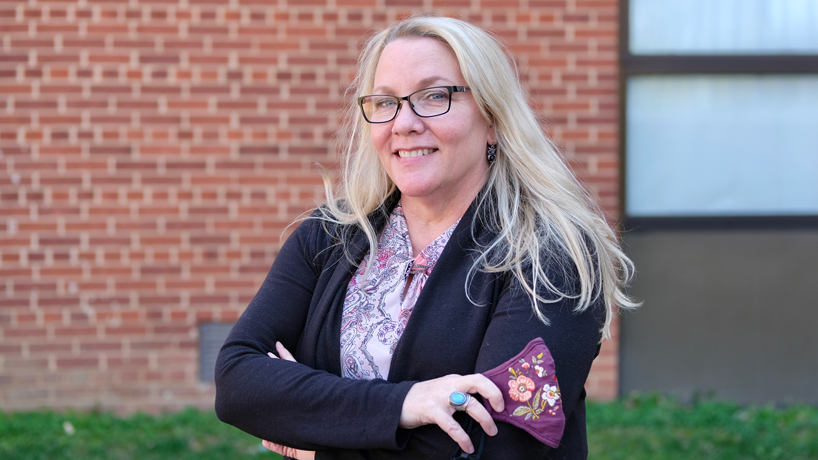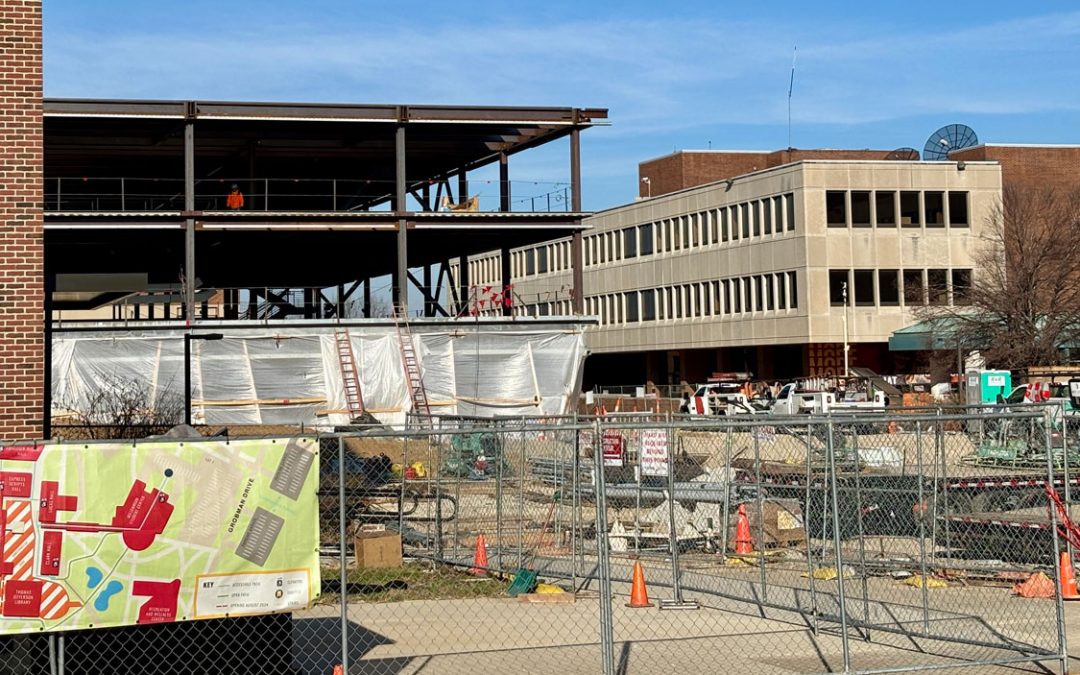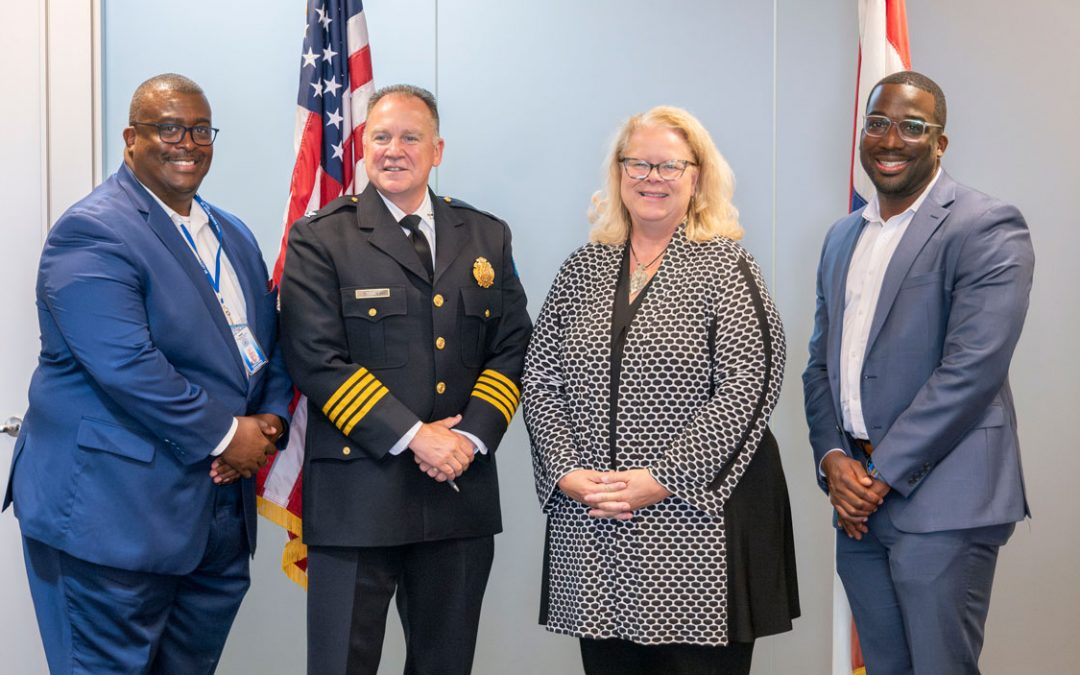
Kelly Taylor was named Hazelwood School District Teacher of the Year by her peers. Taylor, an UMSL education graduate, teaches Honors Biology, Principles of Biomedical Science and AP Environmental Science at Hazelwood West High School. She is also a science instructor for the UMSL Bridge Program and has worked as an AVID tutor. (Photo courtesy of Kelly Taylor)
Kelly Taylor’s first teaching job wasn’t at a school.
It was in the dining room at Cracker Barrel Old Country Store. That’s where she trained new servers, grill cooks and prep cooks for 10 years prior to starting college. This experience came 15 years after graduating from high school, and she never imagined going into education at the time.
“The confidence to be a teacher, that took a while and some convincing,” Taylor said. “When I graduated from high school, I did not graduate with honors by any means. I was ready to be finished with education all together.”
She took a break from school but didn’t give up.
Taylor knew she wanted to pursue a more secure future for herself and her children, and at her husband’s insistence that she could be an educator, she enrolled in junior college. Taylor started gaining confidence in the classroom and went on to excel in higher education, earning a BS in Education from the University of Missouri–St. Louis in 2009, an MS in Biology from Washington University in St. Louis and an EdD from Maryville University.
In addition to earning a terminal degree in her field, Taylor, now a science teacher at Hazelwood West High School, has been recognized for the impact she makes on her students. In February, she was named Hazelwood School District Teacher of the Year by her peers.
“I was stunned initially,” Taylor said of winning the accolade. “I was very surprised, but it’s just an incredible privilege and honor because I work with some of the most amazing educators I’ve ever met. I’ve learned so much, and I’ve grown so much since I’ve been here. It is really humbling to be named teacher of the year when I know that there are so many talented and dedicated teachers in our district.”
After being nominated, Taylor interviewed with district officials for the award in January. She kept waiting for news, but none came. Her curiosity was piqued, however, when she was asked to go to the district photographer for a new headshot.
“I kind of had an inkling, but my principal surprised me,” she said. “He made an announcement in one of our morning meetings. He said, ‘I’d like to make a special announcement.’ I was paying attention, but I wasn’t really expecting it. He said, ‘We want to show a video.’ Then he showed the video of the superintendent making the announcement, and I was speechless.”
It was a rare moment to be left without words given Taylor’s talkative personality, but she felt blessed even if she was also a bit overwhelmed. It was especially rewarding to receive such recognition after her early struggles in school.
That’s not to say Taylor was uninterested in learning. On the contrary, she has been passionate about science from a young age. Her father also shared an interest in the subject, and they often discussed archaeology, biology and forensics.
He encouraged the interest, taking Taylor to visit the Kimmswick Bone Bed in the Mastodon State Historic Site when she was 11. The bones of mastodons and other extinct animals were found there in the early 19th century, and it proved to be one of the most significant ice age fossil deposits in the country.
“I spent two summers with dental picks in a mudhole looking for dinosaur bones,” Taylor said.
Art Kasey, the long-time geology and earth geoscience teacher at Fox High School, also encouraged Taylor’s burgeoning scientific curiosity and had high standards while being supportive. The same could not be said about other teachers – one of whom made Taylor doubt herself and whether she was worthy of an education.
Her early experiences made her question whether she was as smart or capable as her peers. She was held back a year in elementary school, which further reinforced the belief she was not “cut out” for school. However, she still held onto the positive experiences in Kasey’s classroom and digging for dinosaurs.
Before the negative experiences, Taylor loved to pretend to be a teacher.
“I thought if I was going to be a teacher, science would be the thing because you do such cool stuff in science,” she said. “You play in the dirt, and you talk about gross stuff – that would be really cool.”
When Taylor went back to school, it took a while to adjust to the classroom again, but eventually she found a sense of belonging. After earning an associate degree, she first attended Harris-Stowe University before transferring to UMSL, where she joined the AVID program.
AVID, or Advancement Via Individual Determination, is designed to help close achievement gaps and put high school students onto the college track. Taylor served as a tutor and started working with students in St. Louis Public Schools. It’s where her passion for teaching really blossomed.
The connection to AVID led to a position teaching science at Carnahan High School of the Future after she earned her bachelor’s degree. It was just the first opportunity to fall into place during that time.
A partnership between the National Science Foundation and WUSTL made it possible for Taylor to obtain her master’s shortly after finishing her undergraduate studies. The program funded a graduate degree in biology with an emphasis in education for teachers in urban and rural school districts in return for gathering data to ensure the degree led to teachers closing the achievement gap in science education in underserved communities.
Additionally, through her time at UMSL and the AVID program, Taylor became a science instructor for UMSL’s Bridge Program – a year-round college preparation program that focuses on academic enrichment and personal development.
Meanwhile, she decided to pursue an EdD in teacher leadership the year after she finished her master’s degree.
“I’m thought, ‘I gotta strike while the iron is hot. I might as well just do this,’” Taylor said. “On my journey to find ways to best serve my students and continue working on closing the achievement gap, the experience helped me refine my teaching strategies and advocacy for the students I serve. I really was just looking for ways to improve the way I teach children, particularly while I was working at St. Louis Public Schools, where 97 percent of my students are African American.
“Any teacher who teaches children who don’t look like them or do not come from the same culture and background, if they don’t think they need to learn specifically how to teach children with that in mind, they’re kidding themselves. It is imperative that teachers learn to teach from an equity lens. In order to do that, they must examine their own culture as well as the culture of the students they serve.”
A year after finishing her EdD, Taylor moved from Carnahan to Hazelwood West, where she teaches Honors Biology, Principles of Biomedical Science and AP Environmental Science. Moving from a small high school to Hazelwood West was a bit overwhelming at first.
Carnahan had 400 students, while Hazelwood West serves more than 2,100 students. But Taylor enjoys the diversity of the school, which has 27 languages represented in the building, as well as significant Muslim and first-generation African student populations. The larger school has also presented more opportunities to collaborate with colleagues.
Teachers are grouped into PLCs – professional learning communities – by subject, which affords them the ability to create tiered lessons that will connect between classes. The collaborative environment provides support, but also a venue to challenge each other’s thinking. Taylor said it’s a powerful tool that keeps educators from becoming too narrow-minded.
“I also love the fact that we are always working on finding ways to support or further our efforts in equity,” she said. “We’re considering all of our curricular material, all of our delivery methods, all of our expectations in our classrooms to make sure that they are suitable for every student that walks through our doors – not just the status quo. I think education is finally starting to turn that tide.”
The goal is to instill confidence in students and provide them with tools to shift directions in life – something that was often missing from Taylor’s education. She’s not too worried about the students who come through her classroom, though.
“Young people always give me hope for the future,” she said. “Our kids are so resilient, so brilliant and just so progressive – open to thinking, analyzing and weighing different scenarios. I love listening to them, debating and evaluating different situations, especially about our environment and how we fit into it as humans.”














